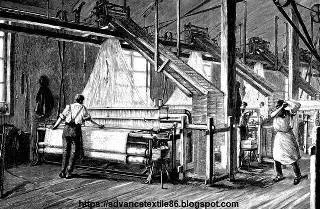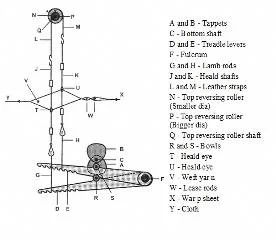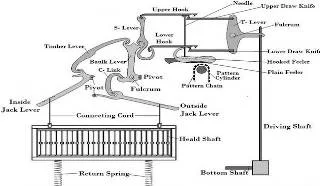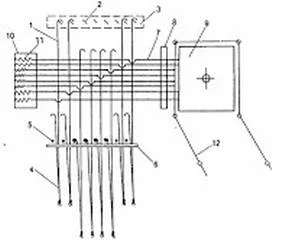Shedding mechanism
The
term shedding refers to the act of creating a shed. Shedding is the process of
making an open path across the warp yarn and through it, some warp threads are
raised by their harness, and others leaving down. When the shed is open, the
filling yarn is inserted. The shed is changed as determined by the pattern. A
shading device is a device used to raise or open a shed. Creating isolation is
called raising or opening the shed, while the opposite is known as lowering or
closing the shed. The type of machine used to raise and lower the shed is
different from the type of loom. The shades are raised and lowered by rotating
the tablets or cards with the help of a tablet loom. Sheds are made by
harnesses in a floor loom. Among the ink looms is another primitive shedding
device, which has a set of heddles, and the shed is made by hand.
Originally
there were no sheds, and like the work of tapestry weaving, the threads of the
warp were individually sorted and inserted into it. After each weft thread was
woven the warp threads had to be picked up and lifted again, which slowed down
the process? To speed up the process, a variety of devices were developed to
create a reproducible shed so that the weft could pass between isolated
threads, and so the threads did not have to be separated individually each
time. The first type of shedding device is called a shed rod. It is a rod that
is inserted into the rail to make weaving easier and came at the same time as
the heddles. The threads on the top and bottom of the rod were changed
periodically and the threads going to the bottom of the rod went through the
string heddles attached to a bar. The shed is made in two ways: by raising the
shed-rod and lifting the heddles.
The shedding mechanism divides the warp threads into two sheets by lifting some of the heald shafts and lowering the others. Since each warp yarn from the weaver's beam passes through one eye of the heald shaft, while some held shafts are lifted and lowered by a shedding mechanism, the corresponding warp edges are raised or lowered thus forming an opening. When this happens, a shed is created and the next initial process, “picking”, can begin. A shed can be created by a variety of shedding mechanisms such as crank, tappet, dobby, and jacquard. The minimum number of heald shafts for shed formation is two. When the number of handle shafts being used is more than two, whether a shaft is lifted or lowered is determined by the weaving structure of the fabric woven into the particular loom.
Types of shedding mechanism
There
are three types of shedding mechanisms. These are-
i.
Tappet shedding
ii.
Dobby shedding
iii.
Jacquard shedding
Tappet shedding
Tappet
shedding uses a tappet and cam to control movement up and down the heald shaft.
Tappet shedding is the easiest shedding motion. It can control 8 heald shafts.
Plain weaving, plain twill, and plain satin and sateen weave can be produced
using tappet shedding. An important type of cam is the one that provides a
rotating motion for the object to produce reciprocating motion in the levers
and rods by the sliding contract. When the rod has to take a series of lifts,
rest breaks and thus creates a shed known as tappet shedding. Tappet shading
has the simplest design capabilities compared to other shadings. It is one of
the most expensive textile looms. The weaving speed of tappet shedding is
comparatively much higher than others. The tappet is usually placed under the
loom during the weaving process. The maximum number of heald shafts in tappet
shedding is fourteen. Tappet shedding produces comparatively more than dobby
and jacquard shedding. Production costs are also very low here.
Opportunities for tappet shedding
i.
Tappet shading uses tappets and cam to control movement up and down the heald
shaft.
ii.
It is the easiest shading motion.
iii.
It can control 8 heald shafts.
iv.
Plain weaving, plain twill, and plain satin and sateen weave can be produced
using tappet shedding.
v.
It has the least versatile shedding motion.
Tappet shedding mechanism (Negative)
Construction
The
figure shows a negative tappet shedding mechanism. A pair of A and B tappets
are fixed 180 degrees to each other in the bottom shaft C. The two treadle
levers D and E are connected to the loom back-rail by a bracket F. The bracket
acts as a complement to the lever. The lamb rod has teeth to carry G and H,
respectively, in two steps. The two held shafts J and K are connected to the
lamb rod. A top reverse roller shaft Q carries two rollers of different
diameters. The small diameter N roller is attached to the leather strap L with
which the front heald shaft J is attached. The large diameter roller P is
attached to the leather strap M with which the rear heald shaft is attached.
Tappets A and B touch the anti-friction bowl or followers R and S, respectively,
which are fixed to the treadle lever. The heald shafts have heald eyes by T and
U through which the warp thread passes X is the warp sheet and the Y is the
cloth. Odd ends pass through one heald shaft while even ends pass through
another heald shaft.
Working Principle
i.
When the bottom shaft is rotated clockwise, the tappets are also rotated. The
tappet will disappoint the anti-friction bowl and treadle.
ii.
With a fulcrum at one end, the front of the treadle goes down. This action is
transferred to the lamb rod, the heald shaft, and the leather strap.
iii.
Thus, a heald shaft is lowered and the threads attached to this heald shaft are
lowered and form the bottom layer of the shed.
iv.
The leather straps attached to the inverted rollers are attached in the
opposite direction, as when the leather strap is pulled down; it is unwound
from the roller.
v.
Therefore, the shaft continues to rotate clockwise and the other leather strap
is wound on its roller. The heald shaft is raised and therefore the lamb rod
and treadle lever are also raised.
vi
Threads attached to the heald shaft are also raised and form the upper layer of
the shed.
vii.
For the next shed, the other tappet works with other bowls, treadles, lamb
rods, heald shafts, straps, and rollers, and the other heald shaft is lowered.
viii.
The first heald shaft is raised by inverted rollers and thus the positions of
the heald shaft are exchanged.
ix.
Thus, for one rotation of the bottom shaft, two shades are formed.
x.
In this type of tappet shedding, therefore, a tappet depresses the
corresponding treadle and lowers the corresponding heald shaft. But the other
heald shaft is raised by inverted rollers. Thus, this type of shedding
mechanism is known as the negative tappet shedding mechanism.
Dobby shedding
Dobby
is a shading device that is placed on top of a loom to create an illustrated
pattern using a greater number of healds than the capacity of the tappet. Infancy weaving, dobby is used to create small figures with warp threads and
healds, while jacquard is used to create very large and elaborate figures with
warp threads and hooks, needles, and harness cords.
Opportunities for dobby shedding
The
opportunities for dobby shedding in the textile industry are as follows-
i.
In the cotton industry, a maximum of 24 shaft dobbies is used. But mostly 16 to
20 shafts are used.
ii.
In the worsted industry, dobbies with 36 jacks are used and many of them are
suitable for positive and heavy shedding.
iii.
Fabric, a dobby loom pattern can be easily made while in the case of tappet, it is
laborious and expensive.
iv.
Dobby shedding offers better facilities for producing a variety of patterns
than is possible with a larger number of held tapes.
v.
Dobby shedding is widely used for twill, satin, and other common weaves.
Dobby shedding mechanism (Negative)
i.When
the connecting rod moves up and down and the T-lever gives external and
internal movement. According to the fabric design, when the peg comes in
contact with the feeder, the right part of the filler is raised and the left
part is lowered. The hooks are lowered because the hooks are supported by a
filler.
ii.
When the left edge of the filler is bent the upper hook comes in contact with
the upper knife. In this case, when the connecting rod goes down, the upper
part of the T-levers gives external movement. As a result, the upper part of
the S-lever, the bulk lever, also moves to the right. Thus, tension is
created between the wooden lever and the link.
iii.
As the outer and inner jack levers are connected to the wooden lever and the
link, the lever moves upwards at the same time. Therefore, the heald shaft has
risen.
iv.
Similarly, when the left edge of the filler is bent, the bottom hook comes in
contact with the bottom knife. In this case, the rod moves upwards when connecting
and the lower part of the T-lever moves to the right. As a result, the lower
part of the S-lever moves to the right and the same process occurs i.e. the
upper part of the bulk lever moves to the right. Here, the jack lever is moved
at the same time.
v.
Therefore, the heald shaft rises again. Thus, a heald shaft is a rise by the
lower knife and the upper knife. Therefore, the shaft will be lowered with the
help of a return spring and will remain below for further selection.
Jacquard shedding
The
Jacquard is a shedding device that is attached to the top of the handloom or to
the power loom and controls a large number of warp threads to create the most
varied sheds for fabric decoration. This process is probably one of the most
important weaving innovations because jacquard shedding has made possible the
automatic production of an unlimited variety of intricate pattern weaving.
Opportunities for Jacquard Shedding
Jacquard
shedding points out various opportunities for shading below:
i.
Each warp yarn can be handled differently at any pick.
ii.
Harness is used to lowering or lifting the warp yarn during weaving.
iii.
No heald frames are used in jacquard sheds or shedding.
iv.
Sophisticated or large or elaborate designs are used for jacquard design.
v.
One warp yarn for each harness cord.
vi.
Minimum figuring capacity is 100s- means minimum. The number of warp
repetitions is less than 100.
vii.
The maximum figuring power is over the 1800s + and the maximum number of warp
repetitions is over the 1800s.
viii.
Using a jacquard shedding, the most expensive fabrics are made.
Jacquard shedding mechanism
The
basic principle of the jacquard shed or shedding mechanism is described below
with the help of a single lift single-cylinder jacquard. Punch cards are used
for jacquard sheds made according to the design. Here, a pattern card is used
for single picking with these pattern cords. A pattern chain is created that
takes place in the pattern cylinder. Here, the pattern card hole indicates the
design warp up. Knives from giraffes that are all tied together. They are moved
down and up from the loom crankshaft. The pattern cards of the perforated
cylinder are pressed against the needle as the giraffe begins to move upwards. If
there is a hole in the pattern cad, the needle just opposite the hole will go
through it and the hole will need a cylinder and a knife if this needle is
attached and forming a line at the top of the jacquard shed or shedding. It
will press the hook and lift the knife if the pattern card is blank opposite
the needle. As a result, the hook is left down. This way any pick of the
Jacquard 408 hook and can be lifted from the bottom line of the Jacquard shed
or shedding.












0 Comments